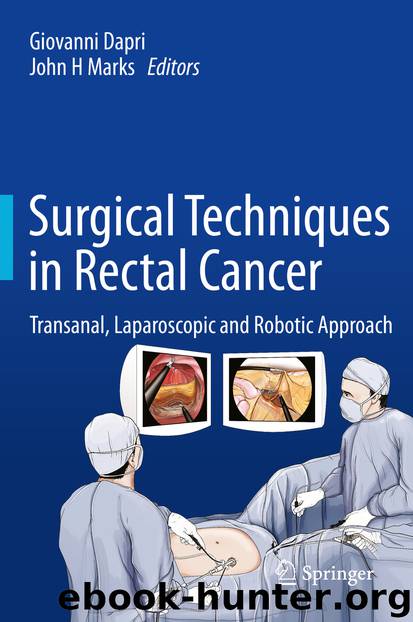Surgical Techniques in Rectal Cancer by Giovanni Dapri & John H Marks

Author:Giovanni Dapri & John H Marks
Language: eng
Format: epub
Publisher: Springer Japan, Tokyo
17.2 Surgical Technique
17.2.1 Abdominal Step
After the induction of the general anesthesia, the patient is placed in Lloyd–Davis position; the surgeon and the assistant are located to the right side of the patient. Pneumoperitoneum is achieved with CO2 at a pressure of 12 mmHg at Palmer’s point (under the ribs on the left side, medium clavicle line.) At the previously demarcated ileostomy site (right lower quadrant), we perform a single incision (2.5–3.0 cm of diameter—depending on the device to be used), and under direct vision, the single-port device is placed in the abdominal wall (Fig. 17.1). We choose to use a 10 mm straight 30° optic. Nowadays it is possible to use a flexible or rigid 5 mm scope. A 5 mm energy device and a 5 mm grasper are used in the two other 5 mm ports, for dissection and hemostasis. It is important to choose an energy device with the capability to grasp, seal vessels, and cut with or without energy. To improve the exposure without the need of extra instruments, the patient is then placed in a Trendelenburg position (35–40°) and right-side tilt (20–25°). To achieve maximum exposure, it is important to fix the patient on the surgical table. We try to avoid shoulder fixation to prevent brachial plexus injury. To facilitate the manipulation of the sigmoid colon, the upper rectum is mobilized posteriorly, and the sigmoid colon is suspended toward the abdominal wall with the transparietal suture at the beginning of the rectal dissection and is mobilized medial to lateral. These maneuvers facilitate and increase the exposure of the rectum, providing a good surgical field to proceed with TME.
Fig 17.1Ileostomy site and single port site
Download
This site does not store any files on its server. We only index and link to content provided by other sites. Please contact the content providers to delete copyright contents if any and email us, we'll remove relevant links or contents immediately.
| Anesthesiology | Colon & Rectal |
| General Surgery | Laparoscopic & Robotic |
| Neurosurgery | Ophthalmology |
| Oral & Maxillofacial | Orthopedics |
| Otolaryngology | Plastic |
| Thoracic & Vascular | Transplants |
| Trauma |
Periodization Training for Sports by Tudor Bompa(8171)
Why We Sleep: Unlocking the Power of Sleep and Dreams by Matthew Walker(6618)
Paper Towns by Green John(5092)
The Immortal Life of Henrietta Lacks by Rebecca Skloot(4526)
The Sports Rules Book by Human Kinetics(4295)
Dynamic Alignment Through Imagery by Eric Franklin(4118)
ACSM's Complete Guide to Fitness & Health by ACSM(3989)
Kaplan MCAT Organic Chemistry Review: Created for MCAT 2015 (Kaplan Test Prep) by Kaplan(3940)
Introduction to Kinesiology by Shirl J. Hoffman(3726)
Livewired by David Eagleman(3684)
The Death of the Heart by Elizabeth Bowen(3552)
The River of Consciousness by Oliver Sacks(3542)
Alchemy and Alchemists by C. J. S. Thompson(3451)
Bad Pharma by Ben Goldacre(3357)
Descartes' Error by Antonio Damasio(3230)
The Emperor of All Maladies: A Biography of Cancer by Siddhartha Mukherjee(3068)
The Gene: An Intimate History by Siddhartha Mukherjee(3048)
The Fate of Rome: Climate, Disease, and the End of an Empire (The Princeton History of the Ancient World) by Kyle Harper(3003)
Kaplan MCAT Behavioral Sciences Review: Created for MCAT 2015 (Kaplan Test Prep) by Kaplan(2940)
